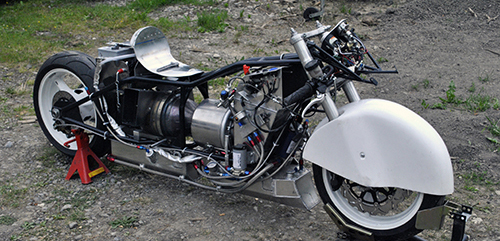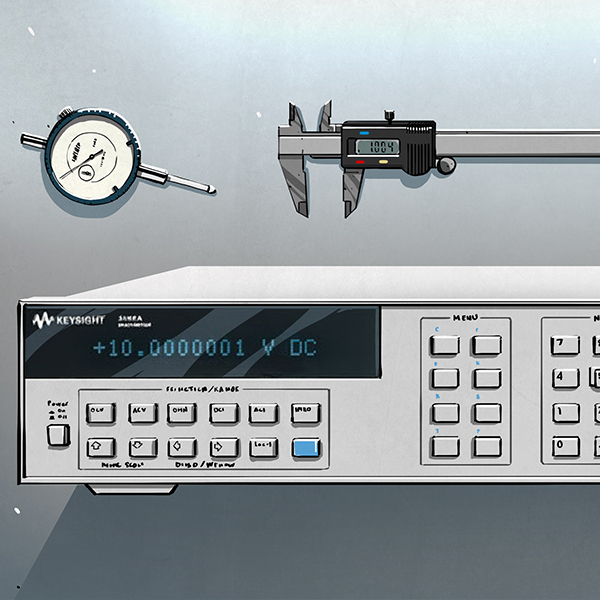For the last four and a half years, [Anders] has been working on a motorcycle project. This isn’t just any old Harley covering a garage floor with oil – this is a gas turbine powered bike built to break the land speed record at Bonneville.
The engine inside [Anders]’s bike is a gas turbine – not a jet engine. There’s really not much difference in the design of these engines, except for the fact that a turbine dumps all the energy into a drive shaft, while a true jet dumps all the energy into the front bumper of the car behind this bike. [Anders] built this engine from scratch, documented entirely on a massive 120 page forum thread. Just about everything is machined by him, bolted to a frame designed and fabricated by him, and with any luck, will break the land speed record of 349 km/h (216mph) on the salt flats of Bonneville.
As with all jet and turbine builds, this one must be heard to be believed. There are a few videos of the turbine in action below, including one where the turbine drives the rear wheel.
















Just to make sure there’s no confusion, a “jet” engine is a type of gas turbine. There are quite a few different configurations and uses of gas turbines:
http://en.wikipedia.org/wiki/Gas_turbine
This is so cool to the max… +1 ;^)
Cool, but the current motorcycle land speed record was set at Bonneville in 2010 by Rocky Robinson: 376.363 MPH (605.697 km/h)
Chances are he’s not going for the same record. There are numerous classes to place a record under for motorcycles.
He plans on breaking the record for experimental propulsion motorcycles (electric, jet engine, steam) which is currently 216MPH.
To pile on to JRDM’s comment, this engine is a turboshaft engine, because the power is directed to a shaft which drives something else. Other applications for turboshaft engines include helicopters and propeller-driven aircraft. Other forms of gas tubine engine which are not turboshaft engines include turbojet and turbofan engines, both of which use the exhaust stream itself to propel the vehicle.
You left out ships. The turbofan could be argued. On high bypass turbofans almost all the thrust comes from the fan and not the exhaust of the the gas turbine.
Turboshaft engines attached to propellers are often referred to as turboprops.
This reminds me of the MTT bike, which is also a turboshaft model, and can technically be called a production vehicle.
http://en.wikipedia.org/wiki/MTT_Turbine_Superbike
don’t foget that the bike is running now ;)
https://www.youtube.com/watch?v=bKRx3L7E5X4
have been a pleasure following his treat for about 2 years now ! :)
Editors: you should link to this video in the article, it’s the best one!
The other riders at the end are very confused.
Pretty amazing. That thing seems significantly faster than my liter bike; which easily runs 200+mph 1/4’s. I want one!
Contrary to the the original post, i don’t see anything Harley about it.
Nice! Though I have to say, for the road test portion… tripods are wonderful things…
Superb!
It’s very very impressive.
As one of the administrators of the JATO forum, I have to tell you we are very fortunate to have Anders onboard and we are very thankful for his documenting this build.
“First test with rear wheel locked”, with a 2X4!?!? Still I have to admit the Swedish Chef has an awesome chopper there!
Looking at the Wikipedia page for gas turbines, it looks like the first documented gas turbine able to produce useful power was built in 1903. Then the tech would get to where it was propelling vehicles in the next few decades through the efforts of governments and companies with teams of scientists and engineers. Now it’s moved to this vehicle today.
It’s awesome how the tech has progressed to where it is ‘accessible’ like this.
supercalifragilisticexpialiAWESOME!
I wonder how this stacks up with the “production” Y2K turbine bike like Jay Leno owns?
This looks faster
Even if it wasn’t crazy fast, the sound alone would make that an amazing bike. Completely awesome!
Just, wow. Makes me embarrassed when I compare my old truck project to this.
“…while a true jet dumps all the energy into the front bumper of the car behind ”
No – that is not how jet engines work. Jet engines primarily use Newton’s third law of motion, ejecting mass at a velocity in one direction to cause the mass of the engine and it’s attached vehicle to be subjected to a force in the opposite direction. Some energy would also be transferred to a following vehicle, but certainly not all of it, otherwise the engine itself would not be propelled forwards.
Not really. Just trying to ensure that the “myth” that jet engines work by pushing against an object doesn’t gain any more traction than it already has. (Pun not intentional)
Go Norrland go!
Awesome sound, would like to hear that bike on the roads some day :)
Stunning build, but … chain drive?
The video of the 1st start scares the crap out of me. No hearing / eye protection… and it looks like what’s known as a “slow start” leading into a “hung start.” A lot of the white vapor you see is unburnt fuel — the engine wasn’t spinning fast enough to handle a light-off at such a low N1. I’ve seen slow starts like this end spectacularly (fireball)… or in a somewhat boring, but engine destroying hung start that massively over-temps.